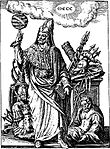
Back Герметычныя кнігі Byelorussian Hermètica Catalan Hermética (textos) Spanish هرمتیکا Persian Hermetica Finnish Hermetica French ヘルメス文書 Japanese 헤르메스주의 문헌 Korean Hermetica Dutch Hermetický spis Slovak
| Part of a series on |
| Hermeticism |
|---|
 |
The Hermetica are texts attributed to the legendary Hellenistic figure Hermes Trismegistus, a syncretic combination of the Greek god Hermes and the Egyptian god Thoth.[1] These texts may vary widely in content and purpose, but by modern convention are usually subdivided into two main categories, the "technical" and "religio-philosophical" Hermetica.
The category of "technical" Hermetica encompasses a broad variety of treatises dealing with astrology, medicine and pharmacology, alchemy, and magic, the oldest of which were written in Greek and may go back as far as the second or third century BCE.[2] Many of the texts belonging in this category were later translated into Arabic and Latin, often being extensively revised and expanded throughout the centuries. Some of them were also originally written in Arabic, though in many cases their status as an original work or translation remains unclear.[3] These Arabic and Latin Hermetic texts were widely copied throughout the Middle Ages (the most famous example being the Emerald Tablet).
The "religio-philosophical" Hermetica are a relatively coherent set of religio-philosophical treatises that were written mostly in the second and third centuries, though the very earliest one of them, the Definitions of Hermes Trismegistus to Asclepius, may go back to the first century CE.[4] They are chiefly focused on the relationship between human beings, the cosmos, and God (thus combining philosophical anthropology, cosmology, and theology). Many of them are also moral exhortations calling for a way of life (the "way of Hermes") leading to spiritual rebirth, and eventually to divinization in the form of a heavenly ascent.[5] The treatises in this category were probably all originally written in Greek, although some of them survive only in Coptic, Armenian, or Latin translations.[6] During the Middle Ages, most of them were only accessible to Byzantine scholars (an important exception being the Asclepius, which mainly survives in an early Latin translation), until a compilation of Greek Hermetic treatises known as the Corpus Hermeticum was translated into Latin by the Renaissance scholars Marsilio Ficino (1433–1499) and Lodovico Lazzarelli (1447–1500).[7]
Though strongly influenced by Greek and Hellenistic philosophy (especially Platonism and Stoicism),[8] and to a lesser extent also by Jewish ideas,[9] many of the early Greek Hermetic treatises also contain distinctly Egyptian elements, most notably in their affinity with traditional Egyptian wisdom literature.[10] This used to be the subject of much doubt, but it is now generally admitted that the Hermetica as such did in fact originate in Hellenistic and Roman Egypt, even if most of the later Hermetic writings (which continued to be composed at least until the twelfth century CE) did not. It may even be the case that the great bulk of the early Greek Hermetica were written by Hellenizing members of the Egyptian priestly class, whose intellectual activity was centred in the environment of Egyptian temples.
- ^ A survey of the literary and archaeological evidence for the background of Hermes Trismegistus in the Greek Hermes and the Egyptian Thoth is found in Bull 2018, pp. 33–96.
- ^ Copenhaver 1992, p. xxxiii; Bull 2018, pp. 2–3. Garth Fowden is somewhat more cautious, noting that our earliest testimonies date to the first century BCE (see Fowden 1986, p. 3, note 11).
- ^ Van Bladel 2009, p. 17.
- ^ Copenhaver 1992, p. xliv; Bull 2018, p. 32. The sole exception to the general dating of c. 100–300 CE is The Definitions of Hermes Trismegistus to Asclepius, which may date to the first century CE (see Bull 2018, p. 9, referring to Mahé 1978–1982, vol. II, p. 278; cf. Mahé 1999, p. 101). Earlier dates have been suggested, most notably by Flinders Petrie (500–200 BCE) and Bruno H. Stricker (c. 300 BCE), but these suggestions have been rejected by most other scholars (see Bull 2018, p. 6, note 23).
- ^ Bull 2018, p. 3.
- ^ E.g., The Discourse on the Eighth and Ninth (Coptic; preserved in the Nag Hammadi library, which consists entirely of works translated from Greek into Coptic; see Robinson 1990, pp. 12–13), the Definitions of Hermes Trismegistus to Asclepius (Armenian; see Bull 2018, p. 9), and the Asclepius (also known as the Perfect Discourse, Latin; see Copenhaver 1992, pp. xliii–xliv).
- ^ Copenhaver 1992, pp. xl–xliii; Hanegraaff 2006, p. 680.
- ^ Bull 2018, p. 2.
- ^ See, e.g., Pearson 1981, and the copious references in Bull 2018, p. 29, note 118.
- ^ Mahé 1978–1982. Mahé also demonstrated numerous other Egyptian influences on the Hermetica (cf. Bull 2018, pp. 9–10).